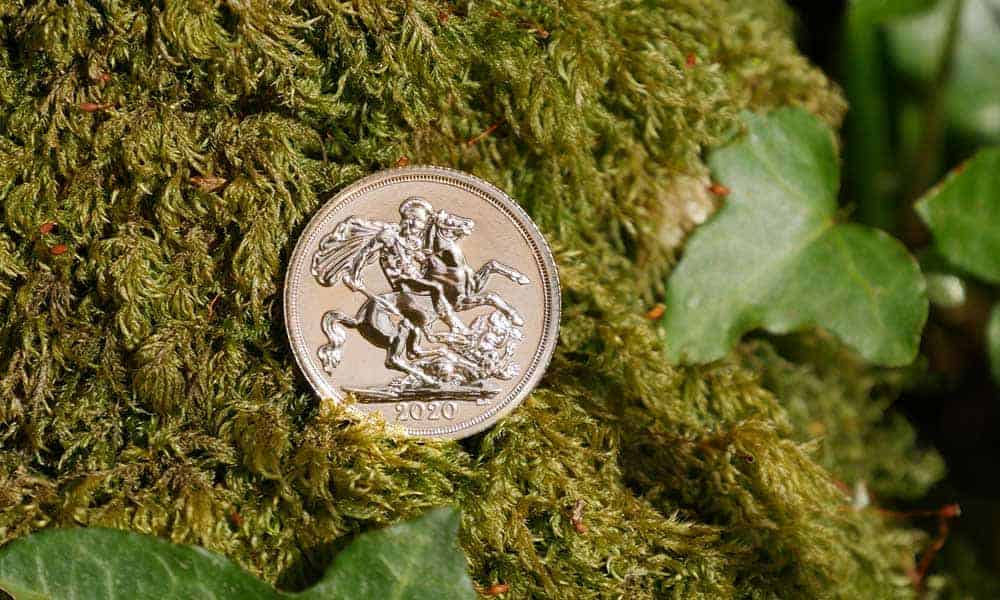Saint George is one of the most iconic symbols in recent history. Since 1817, he’s been featured on the world-famous UK sovereign coin, and most recently, the UK Valiant coins. We explored who Saint George was and why he appears so often on sovereign and other bullion coins from the UK.
Why is Saint George important?
Saint David of Wales, Saint Andrew of Scotland, Saint Patrick of Ireland. Every nation has its own patron saint. England’s patron saint is Saint George who’s death is still celebrated in the UK every year, nearly 2,000 years after his existence. The Cross of Saint George also continues to take its place amongst national pride as the official national flag of England.
Did you know – Saint George might be hailed as a national hero, but he was actually born more than 2,000 miles away? He’s thought to have been born in Cappodocia (modern-day Turkey) and to have died in Lydda (modern-day Israel) in the Roman province of Palestine in AD 303.
So, what is the significance of Saint George, and why is he still an emblem of English heritage? Well, according to historian Ian Mortimer, a patron saint did not have to be from the country they were born in. They just needed to embody the characteristics the kingdom wanted to project to the outside world.
“He almost certainly was a real historical figure, most probably a Christian Roman soldier named Georgios,” confirms Dr Michael Carter, a historian at English Heritage.
Legend has it that when George grew up he became a soldier and joined the retinue of Emperor Diocletian. What made him famous amongst Christians, in particular, happened in 303, when Roman Emperor Diocletian (as part of a crackdown on the growing influence of the Christian movement) ordered that all Christian soldiers be expelled from the army, renounce their Christian beliefs and make a pagan sacrifice.
Saint George refused and was seen as a ‘martyr’ for Christianity. A further look into Christian theology, Dr Carter says “some stories say he was tortured for seven years, in which every conceivable horror was inflicted upon him. He was crucified, racked, broken on the wheel, boiled alive and poisoned. Legend says he’d died on three occasions and was brought back to life by Saint Michael, before being beheaded at the end.”
He was declared the country’s official saint by King Edward III just after he came to the throne in 1327, and following on from the Battle of Agincourt in 1415, Saint George’s Day became one of the most important feast days in the English calendar.
Did you know – Saint George is also the patron saint of many other countries including; Portugal, Venice, Beirut, Malta, Ethiopia, Georgia, the Palestinian territories, Serbia and Lithuania?
The Myth Explained
Many stories have been shared about the legend of Saint George slaying the dragon, but the true origin is still relatively unknown.
It originally appeared in stories told by the medieval Eastern Orthodox Church which were then brought back to Europe by the Crusaders in the 10th century. The story of George slaying the dragon was then further published in The Golden Legend written by 13th-century Archbishop of Genoa Jacobus de Voragine.
According to one story, a town in Libya had a small lake with a plague-infected dragon living in it. The townspeople were gradually being killed by the dragon and started feeding it two sheep a day to appease it. When they ran out of sheep the king devised a lottery system to feed it local children. One day his own daughter was chosen and as she was being led out to the lake St George happened to ride past. He reportedly offered to slay the dragon if the people were baptised and converted to Christianity. The king did as he was told, George killed the dragon and everyone was saved.
According to another story, some claim the mound at Uffington next to the White Horse in Oxfordshire is the site where St George fought the dragon, (BBC, 2010).
Why is Saint George on Gold Sovereign Coins?
Saint George has featured on the UK gold sovereign since 1817 (Royal Mint, 2020), and is considered to be one of the world’s most widely recognised coins. Italian engraver Benedetto Pistrucci, depicted St George and the dragon deliberately with the intention of making the UK sovereign coin look as distinctive as possible. The reverse has rarely changed in 200 years, with only a handful of designs appearing on it.
The Royal Mint has since produced newer UK Silver Valiant coins that also feature more dynamic images of Saint George and the dragon.
There’s so much in the legend of Saint George that resonates with English values. He’s diverse and international, and represents; honour, bravery, royal, and military associations. He really is a patron of modern Britain. He also captures the classic embodiment of good conquering evil and represents heritage and tradition, making for a very suitable icon to be printed on Sovereign coins.
If you would like to add some bullion coins to your collection, you can order through the website, speak to a friendly Bleyer team member on 01769 618 618, or email sales@bleyer.co.uk.




